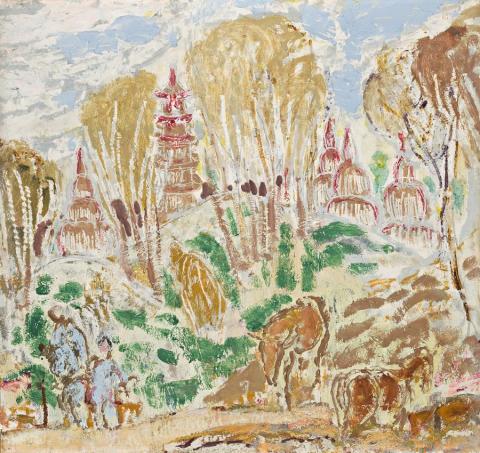TOMBS IN PEKING, 1936
Ian Fairweather
oil on compressed card
51.0 x 54.0 cm
Redfern Gallery, London
Lady Strathcona, London, acquired from the above 1936
Thence by descent
Private collection, Sydney
Ian Fairweather, Redfern Gallery, London,7 January - 30 January, 1937, cat. 15 (label attached verso)
Ian Fairweather has long been admired for the fusion he achieved between Chinese and Western ideas and techniques, with his early Chinese works being rightly regarded as among the great achievements in Australian art. This is seen as much in the philosophical and universal within his art, as in his brilliant use of line drawn on the delicacy and power of Chinese calligraphy. Artist and critic James Gleeson once described his paintings as being 'infused with the living spirit of Chinese art.'1 Fairweather himself remarked, 'I took on, unconsciously I believe, many Chinese attitudes...'2 It was also commented on when this painting was shown in Fairweather's exhibition of Chinese paintings at the Redfern Gallery, London in January 1937. It was his second exhibition at this prestigious gallery, following on from that, also held in January, of 1936. The critic for The Times wrote with warmth and admiration.
'There seems to be more than a chance connection between the subject matter and the general effect of the paintings because, though he is completely Western and, in the broader sense, Impressionistic, in his methods it is evident that he has temperamental affinities with Eastern artists. His colour schemes remind one of Chinese frescoes, in which every tint is subdued and away from its name. With this taste in colour he combines a free style of drawing, avoiding sharp definition, and inclining to the calligraphic in character...'3
Fairweather made two visits to China, the first from 1929 to 1933, when he studied Mandarin and traveled widely. After spending some time in Bali, Australia and the Philippines, he returned early in 1935, staying until April of the following year. Painting fulltime, he lived in Peking (modern day Beijing) away from European people and influences. Here he made a special study of the work of the master calligraphers, their presence being as much felt in Tombs in Peking as in such accompanying works as 'Temple Yard, Peking and Tethered Horses Outside Gate, Peking' all of 1936. Fairweather followed the Chinese masters who, 'with a few strokes of the brush, dramatic, delicate' were able to achieve 'tremendous power of suggestion and imagination'.4 The ancient city of Peking surrounded by its great walls provided Fairweather with endless opportunities to capture the exotic passing scene in its various moods and moments. Back in his studio, he translated about twelve into paintings, the remaining sketches being used over the years for Chinese subjects painted while in the Philippines, India and Australia.
Tombs in Peking 1936 is one of the precious few painted in China, seen in the freshness of the imagery and the immediacy of its realisation. The shallow depth of field adds to the tapestry-like effect of the painting. He was also inclined to reduce some of his paintings, as in Temple, Peking 1936, almost to pure colour, full of lively movement and visual engagement. The most striking features of Tombs in Peking are certainly colour and harmony. Applied with swift touches of the brush, colours dance across the picture plane, definition sometimes aided by the line drawn in the pigment with the other end of the brush. Overall the images are effectively generalised as form echoes form distinguished by colour. Unity of technique is similarly achieved in figuration, with humans, animals, trees and temples all as one. In this masterpiece of felt observation, the past is in living harmony with the present, both in its subject and in Fairweather's realisation of it.
1. Gleeson, J., 'Fusing art forms', Sun-Herald, Sydney, 16 May 1965, p. 82
2. Ian Fairweather quoted in Bail, M., Ian Fairweather, Murdoch Books, Sydney, 2009, p. 19
3.'Paintings Of China: Exhibition In London', Times, 22 January 1937, p. 17
4. Ian Fairweather quoted in Bail, op. cit., and p. 46
DAVID THOMAS
